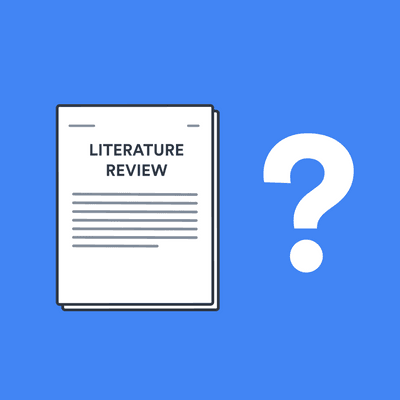What is a literature review? [with examples]

What is a literature review?
A literature review is an assessment of the sources in a chosen topic of research.
In a literature review, you’re expected to report on the existing scholarly conversation, without adding new contributions.
If you are currently writing one, you've come to the right place. In the following paragraphs, we will explain:
- the objective of a literature review
- how to write a literature review
- the basic format of a literature review
The purpose of a literature review
The four main objectives of a literature review are:
- Studying the references of your research area
- Summarizing the main arguments
- Identifying current gaps, stances, and issues
- Presenting all of the above in a text
Ultimately, the main goal of a literature review is to provide the researcher with sufficient knowledge about the topic in question so that they can eventually make an intervention.
How to write a literature review
The format of a literature review is fairly standard. It includes an:
- introduction that briefly introduces the main topic
- body that includes the main discussion of the key arguments
- conclusion that highlights the gaps and issues of the literature
➡️ Take a look at our guide on how to write a literature review to learn more about how to structure a literature review.
The format of a literature review
General formatting rules
First of all, a literature review should have its own labeled section. You should indicate clearly in the table of contents where the literature can be found, and you should label this section as “Literature Review.”
➡️ For more information on writing a thesis, visit our guide on how to structure a thesis.
The length of a literature review
There is no set amount of words for a literature review, so the length depends on the research. If you are working with a large amount of sources, it will be long. If your paper does not depend entirely on references, it will be short.
Literature review examples
Take a look at these three theses featuring great literature reviews:
- School-Based Speech-Language Pathologist's Perceptions of Sensory Food Aversions in Children [PDF, see page 20]
- Who's Writing What We Read: Authorship in Criminological Research [PDF, see page 4]
- A Phenomenological Study of the Lived Experience of Online Instructors of Theological Reflection at Christian Institutions Accredited by the Association of Theological Schools [PDF, see page 56]
Frequently Asked Questions about literature reviews
⏰ How is a literature review defined?
A literature review is an assessment of the sources in a chosen topic of research.
🔍 Where do you find literature reviews?
Literature reviews are most commonly found in theses and dissertations. However, you find them in research papers as well.
🌀 How long should a literature review be?
There is no set amount of words for a literature review, so the length depends on the research. If you are working with a large amount of sources, then it will be long. If your paper does not depend entirely on references, then it will be short.
👬🏾 Should a literature review be combined with the introduction?
No. A literature review should have its own independent section. You should indicate clearly in the table of contents where the literature review can be found, and label this section as “Literature Review.”
🥺 Why should I include a literature review in my paper?
The main goal of a literature review is to provide the researcher with sufficient knowledge about the topic in question so that they can eventually make an intervention.


